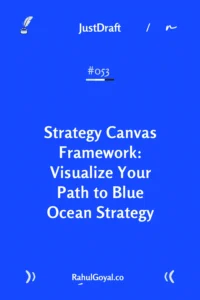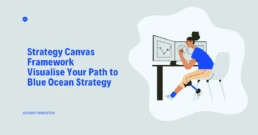Strategy Canvas Framework Visualise Your Path to Blue Ocean Strategy
“We’re doing everything our competitors do and better. But customers still don’t see us as different.” Sound familiar, or you might have experienced it.
If you draw a simple graph. Horizontal axis: all the things his industry competed on. Vertical axis: how much each company offered. Then chance are lines seems nearly identical.
“That’s your problem,”. “You’re fighting in a red ocean.” That’s where Strategy Canvas is useful, a one-page visual tool from W. Chan Kim and Renée Mauborgne in their classic Blue Ocean Strategy.
One Topic: The Strategy Canvas
What Makes Companies Stand Out?
Back in 2005, two professors at INSEAD – W. Chan Kim and Renée Mauborgne, published a book called “Blue Ocean Strategy.” They studied 108 companies over 30 years and found something surprising.
Only 14% of new business launches tried to create something truly different. But these launches generated 38% of revenues and 61% of profits.
Think about that. A small group of companies that chose to be different made most of the money.
The tool they created to visualize this? The Strategy Canvas.
It’s just one page. But it shows you exactly where you’re wasting money trying to match competitors and where you could break away to create your own space.
How It Works
The Strategy Canvas is simple. Draw a graph.
On the bottom (horizontal axis), list everything your industry competes on. Start with price. Then add things like service, features, convenience, quality – whatever customers actually care about when they buy.
On the side (vertical axis), show how much you offer in each area. Low to high.
Now plot your company’s offerings across these factors and connect the dots. That’s your value curve.
Do the same for your top three competitors.
Here’s what you’ll probably see: all the lines look similar. Everyone’s fighting for the same customers using the same weapons. That’s a red ocean – bloody, competitive, exhausting.
Real Examples That Changed Everything
Let me share a few stories that show this in action.
Cirque du Soleil looked at the dying circus industry. Traditional circuses were losing to TV, video games, and sports. They all competed on the same things: star performers, animal acts, multiple rings, concession sales.
Cirque du Soleil eliminated most of that. No animals. No stars. No multiple rings. Instead, they created something new: theatrical circus with artistic themes, refined venues, and multiple productions. They charged 3-5 times more than regular circuses.
In 20 years, they reached 150 million people – something that took Ringling Bros. over 100 years.
Southwest Airlines looked at how major airlines competed: first class, meals, assigned seats, multiple fare classes, lounges, hub connectivity.
Southwest eliminated or reduced most of that. Instead, they focused on what business travelers actually wanted: frequent flights, fast boarding, friendly service, low cost. They positioned themselves not against other airlines but against driving.
Result? 48 consecutive years of profit. The only major US carrier to achieve that.
Yellow Tail Wine saw an industry split between premium wines (complex, intimidating) and cheap wines (poor quality). They created something different: easy-drinking, fun wine that didn’t intimidate.
They put it next to beer in stores. Simple flavors. Fun labels. They targeted beer drinkers, not wine snobs.
Within two years, they became the top imported wine in the US.
The Four Questions That Change Strategy
Kim and Mauborgne created a tool to go with the Strategy Canvas. They call it the Four Actions Framework. It asks four questions:
- What should you eliminate? Look at factors the industry takes for granted. Which ones don’t really create value? Cirque du Soleil eliminated expensive star performers and animal shows.
- What should you reduce? Where is your industry over-delivering? Yellow Tail reduced wine complexity and aging variation – things that scared away casual drinkers.
- What should you raise? What matters to customers but gets under-delivered? Southwest raised flight frequency and speed.
- What should you create? What has the industry never offered? Nintendo Wii created motion-controlled gaming that got families moving together – something hardcore gamers never asked for but millions loved.
The Wii sold over 100 million units and expanded the gaming market five times.
How to Use This Tomorrow
You don’t need consultants or complex software. Here’s how to start:
- Grab a piece of paper. List your top three competitors.
- Write down 10-15 things your industry competes on. Ask customers what drives their purchase decisions – not what you think matters.
- Rate each factor from 1-10 for your company and each competitor.
- Plot the lines and connect the dots.
Now look at where the lines converge. That’s where you’re wasting money fighting the same battle as everyone else.
Look at where they diverge. That’s where someone has found an advantage.
Three Signs You’ve Got It Right
When you sketch a new value curve for your company, Kim and Mauborgne say it should have three characteristics:
- Focus. Your curve should show clear peaks and valleys, not a flat line trying to match competitors on everything. You can’t be everything to everyone.
- Divergence. Your curve should look different from competitors. High where they’re low. Low where they’re high. Creating factors they don’t offer.
- Compelling tagline. You should be able to explain your strategy in one clear sentence. Yellow Tail: “Fun, accessible wine for everyone.” Nintendo Wii: “Where everyone can play.”
If you can’t explain it simply, you probably haven’t found real differentiation yet.
The Traps to Avoid
Some common mistakes when using this tool,
- The benchmarking trap. They plot their strategy but then just try to beat competitors on the same factors. That’s still red ocean thinking.
- The internal focus trap. They rate their offerings based on what they think they deliver, not what customers perceive. Always validate with customer research.
- The incremental thinking trap. They make small adjustments instead of breakthrough changes. Real blue oceans require eliminating and creating, not just tweaking.
Why This Still Matters
Twenty years after the book came out, over 60% of Fortune 500 companies use Blue Ocean Strategy frameworks. The book has sold over 4 million copies in 46 languages.
Why? Because most strategy feels complicated and abstract.
The Strategy Canvas makes it visible. One page. One picture. Immediate insight.
You can see where you’re the same as everyone else. You can see where you’re different. You can see what needs to change.
In my years working with companies, I’ve found that clarity beats complexity. When everyone in your organisation can see your strategy in one simple picture, they can help you execute it.

Interested in travel, read last week’s LensLetter newsletter about Photography Is More Than Just Clicking.
Read last week’s JustDraft about 3 horizons model.
Two Quotes to Inspire
The most dangerous competition is the one you don’t see, competing on the same factors as everyone else without realising you’ve become identical.
Strategy isn’t about being better than competitors; it’s about making competition irrelevant by creating value no one else offers.
One Passage From My Bookshelf
“To fundamentally shift the strategic canvas of an industry, you must begin by reorienting your strategic focus from competitors to alternatives, and from customers to non-customers of the industry. To pursue both value and cost, you should resist the old logic of benchmarking competitors and choosing between differentiation and cost leadership. As you shift your strategic focus from current competition to alternatives and noncustomers, you gain insight into how to redefine the problem the industry focuses on and thereby reconstruct buyer value elements that reside across industry boundaries. Conventional strategic logic, by contrast, drives you to provide better solutions than your rivals to existing problems the industry competes on.
Blue ocean strategy, by contrast, is about breaking the value-cost trade-off to open up new market space. When a company’s strategic position is internally driven, it often finds itself in the trap of competing along the same, often superficial dimensions as rivals. But when a company’s strategic position is defined from the outside in—when the company understands the full scope of alternative industries, strategic groups, buyer groups, complementary product and service offerings, and the functional-emotional orientation of the industry that company can see what others cannot. It can also unlock new demand, making competition irrelevant.”
📚From “Blue Ocean Strategy” by W. Chan Kim and Renée Mauborgne


